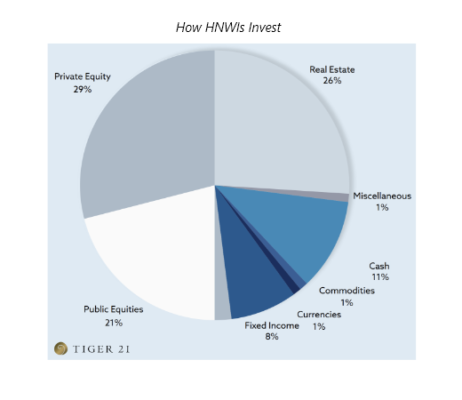There’s no documented proof that Thomas Jefferson ever said the following statement, but the wisdom of those words is undeniable.
“If you want something you’ve never had, you must be willing to do something you’ve never done.”
–Thomas Jefferson (unconfirmed)
Do you aspire to be wealthy?
Have you ever seriously considered the above question? Do you aspire to be one of those wealthy, high-net-worth individuals (HNWIs) you constantly read about or hear about in the news or on the internet, or are you content to be middle-class?
If the answer is the former, then maybe it’s time for a self-assessment.
When it comes to investing, there’s a stark contrast between the average middle-class investor and the ultra-wealthy. And it’s not just a matter of the amount of money they invest, but how they invest it. Recent data from the American Association of Individual Investors (AAII) Asset Allocation Survey and the Tiger 21 Annual Asset Allocation Report (Q1 2024) paints a clear picture of the differing strategies between the middle class and the ultra-wealthy.

 Asset Allocation Comparison
Asset Allocation Comparison
How the Middle Class Invests…
According to the AAII Asset Allocation Survey, the average individual investor’s portfolio is heavily weighted toward publicly traded stocks and bonds. On average, these investors allocate about 60% of their portfolio to stocks and 20% to bonds, with the remaining 20% spread across cash, real estate, and other assets. This aligns with the traditional 60/40 allocation of 60% to stocks and 40% to bonds to attempt to capitalize on growth from stocks while hedging with bonds during market downturns.
Does the 60/40 strategy work? Not really. In 2023, both Yahoo! Finance and The Wall Street Journal published articles declaring this strategy ineffective for building wealth.
The middle class gravitates towards stocks and bonds almost out of convenience. Stocks are easily available through 401(k)s, IRAs, and brokerage accounts, and they have been promoted as a primary investment vehicle for decades. This has led to a form of social conditioning by family, the educational system, and corporate America, where the middle class believes that the path to financial security and growth solely runs through Wall Street.
How the Wealthy Invest…
Tiger 21 is an exclusive peer network of HNWIs with a minimum of $50 million in investable assets required for membership. Each quarter, Tiger 21 releases its asset allocation report, which reflects the investment behaviors of its members. In its latest report, Tiger 21 reported its members allocating 29% to private equity and 26% to real estate. The asset allocation of over 50% of their portfolios to these income-producing alternative assets is consistent with HNWIs and institutional investors across the board.
Why Alternatives?
While the middle class hedges against the volatility of stocks with bonds, the problem is that this strategy is basically just a stop-loss measure. It’s designed to hedge against severe hemorrhaging of a portfolio during a downturn but is not meant to generate income and growth that outpaces inflation or market losses.
HNWIs have a different mentality. In a downturn, they want to keep making money and growing their wealth. The preference for private equity and real estate over stocks can be attributed to a strategy to insulate a portfolio and portfolio income from market volatility induced by economic factors such as inflation, high interest rates, unemployment, etc. While stocks are highly correlated to broader economic factors, alternatives such as private equity and real estate are seen as better hedges against inflation and provide more stable, predictable income and growth.
The High-Net-Worth Challenge…
Assess your current allocations:
Of the two different classes of investors, who do you aspire to be? The middle class or ultra-wealthy?
Who are you modeling your investments after? The middle class or ultra-wealthy?
Are you allocating to private equity or real estate?
If not, what’s keeping you from investing in private equity? If you are invested in private equity and real estate, are you allocating more than 50% of your assets to these classes?
Why Real Estate and Private Equity?
Real estate, particularly commercial real estate (CRE), has long been a favored asset class for the ultra-wealthy. It provides stable, predictable income through rental yields and has historically outperformed the S&P 500 over a 25-year period with reduced risk. CRE investments also offer inflation protection, as rents and property values tend to rise with inflation.
Private equity (PE) investments allow the ultra-wealthy to invest directly in private companies, providing the opportunity for significant returns from both cash flow and appreciation. PE can also offer more control over investments and the ability to drive growth through the active management of skilled professionals. Like CRE, PE investments generate consistent income and can grow in value over time, providing both stability and growth.
Access is no longer an excuse.
One of the main reasons the middle class has not traditionally invested in CRE and PE is due to access. Historically, these investments were exclusive to accredited investors due to SEC regulations. However, that is no longer the case. Recent changes have loosened these restrictions, making it possible for non-accredited investors to invest in alternative assets through crowdfunding platforms and other avenues. The SEC has also loosened advertising rules, making it now possible for private companies to reach out to potential investors through advertising and general solicitation.
Take the High-Net-Worth Challenge…
Take the high-net-worth challenge and reconsider your investment strategies. The ultra-wealthy have long allocated to alternative assets and have paved the way for others to model their investing behaviors. The results speak for themselves. With accessibility barriers coming down, middle-class investors now have the opportunity to emulate these strategies and potentially achieve better financial outcomes.
If you want something you’ve never had, you must be willing to do something you’ve never done. If you want to be a high-net-worth individual, invest like one.

